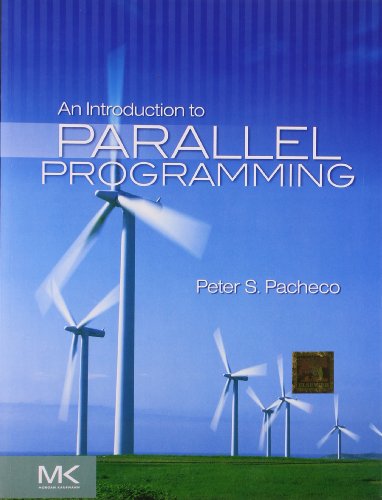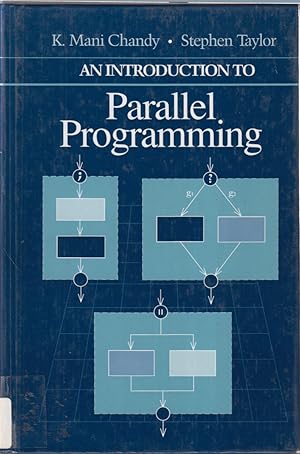introduction parallel programming (155 Ergebnisse)
Suchfilter
Produktart
- Alle Product Types
- Bücher (155)
- Magazine & Zeitschriften (Keine weiteren Ergebnisse entsprechen dieser Verfeinerung)
- Comics (Keine weiteren Ergebnisse entsprechen dieser Verfeinerung)
- Noten (Keine weiteren Ergebnisse entsprechen dieser Verfeinerung)
- Kunst, Grafik & Poster (Keine weiteren Ergebnisse entsprechen dieser Verfeinerung)
- Fotografien (Keine weiteren Ergebnisse entsprechen dieser Verfeinerung)
- Karten (Keine weiteren Ergebnisse entsprechen dieser Verfeinerung)
- Manuskripte & Papierantiquitäten (Keine weiteren Ergebnisse entsprechen dieser Verfeinerung)
Zustand Mehr dazu
Weitere Eigenschaften
- Erstausgabe (5)
- Signiert (Keine weiteren Ergebnisse entsprechen dieser Verfeinerung)
- Schutzumschlag (Keine weiteren Ergebnisse entsprechen dieser Verfeinerung)
- Angebotsfoto (47)
- Keine Print-on-Demand Angebote (138)
Sprache (3)
Gratisversand
Land des Verkäufers
Verkäuferbewertung
-
Zustand: Good. Ships same or next business day with delivery confirmation. Good condition. May or may not contain highlighting. Expedited shipping available.
-
Zustand: As New. Like New condition. A near perfect copy that may have very minor cosmetic defects.
-
An Introduction to Parallel Programming
Verlag: Morgan Kaufmann Publishers, 2011
ISBN 10: 0123742609 ISBN 13: 9780123742605
Sprache: Englisch
Anbieter: ThriftBooks-Reno, Reno, NV, USA
Hardcover. Zustand: Very Good. No Jacket. May have limited writing in cover pages. Pages are unmarked. ~ ThriftBooks: Read More, Spend Less.
-
An Introduction to Parallel Programming
Verlag: Morgan Kaufmann Publishers, 2011
ISBN 10: 0123742609 ISBN 13: 9780123742605
Sprache: Englisch
Anbieter: ThriftBooks-Phoenix, Phoenix, AZ, USA
Hardcover. Zustand: Very Good. No Jacket. May have limited writing in cover pages. Pages are unmarked. ~ ThriftBooks: Read More, Spend Less.
-
An Introduction to Parallel Programming
Verlag: Morgan Kaufmann Publishers, 2011
ISBN 10: 0123742609 ISBN 13: 9780123742605
Sprache: Englisch
Anbieter: ThriftBooks-Dallas, Dallas, TX, USA
Hardcover. Zustand: Very Good. No Jacket. May have limited writing in cover pages. Pages are unmarked. ~ ThriftBooks: Read More, Spend Less.
-
An Introduction to Parallel Programming
Verlag: Morgan Kaufmann Publishers, 2011
ISBN 10: 0123742609 ISBN 13: 9780123742605
Sprache: Englisch
Anbieter: ThriftBooks-Atlanta, AUSTELL, GA, USA
Hardcover. Zustand: Very Good. No Jacket. May have limited writing in cover pages. Pages are unmarked. ~ ThriftBooks: Read More, Spend Less.
-
An Introduction to Parallel Programming
Verlag: Morgan Kaufmann Publishers, 2011
ISBN 10: 0123742609 ISBN 13: 9780123742605
Sprache: Englisch
Anbieter: ThriftBooks-Atlanta, AUSTELL, GA, USA
Hardcover. Zustand: Good. No Jacket. Missing dust jacket; Pages can have notes/highlighting. Spine may show signs of wear. ~ ThriftBooks: Read More, Spend Less.
-
Introduction to Parallel Programming
Verlag: Elsevier India (edition First Edition), 2011
ISBN 10: 0123742609 ISBN 13: 9780123742605
Sprache: Englisch
Anbieter: BooksRun, Philadelphia, PA, USA
Erstausgabe Internationale Ausgabe
Paperback. Zustand: Good. First Edition. It's a preowned item in good condition and includes all the pages. It may have some general signs of wear and tear, such as markings, highlighting, slight damage to the cover, minimal wear to the binding, etc., but they will not affect the overall reading experience. International edition.
-
Hardcover. Zustand: Good. Connecting readers with great books since 1972! Used textbooks may not include companion materials such as access codes, etc. May have some wear or writing/highlighting. We ship orders daily and Customer Service is our top priority!
-
Paperback. Zustand: Fair. No Jacket. Readable copy. Pages may have considerable notes/highlighting. ~ ThriftBooks: Read More, Spend Less.
-
Paperback. Zustand: Very Good. No Jacket. May have limited writing in cover pages. Pages are unmarked. ~ ThriftBooks: Read More, Spend Less.
-
Paperback. Zustand: Good. No Jacket. Pages can have notes/highlighting. Spine may show signs of wear. ~ ThriftBooks: Read More, Spend Less.
-
Zustand: Very Good. Very Good condition. A copy that may have a few cosmetic defects. May also contain light spine creasing or a few markings such as an owner's name, short gifter's inscription or light stamp.
-
Zustand: very_good. Supports Goodwill of Silicon Valley job training programs. The cover and pages are in very good condition! The cover and any other included accessories are also in very good condition showing some minor use. The spine is straight, there are no rips tears or creases on the cover or the pages.
-
Introduction to Parallel Programming
Verlag: Jones & Bartlett Learning, LLC, 1991
ISBN 10: 0867202084 ISBN 13: 9780867202083
Sprache: Englisch
Anbieter: Better World Books, Mishawaka, IN, USA
Erstausgabe
Zustand: Very Good. First Edition. Former library book; may include library markings. Used book that is in excellent condition. May show signs of wear or have minor defects.
-
Introduction to Parallel Programming
Verlag: Elsevier Science & Technology, 1989
ISBN 10: 0121284700 ISBN 13: 9780121284701
Sprache: Englisch
Anbieter: Better World Books, Mishawaka, IN, USA
Zustand: Very Good. Former library book; may include library markings. Used book that is in excellent condition. May show signs of wear or have minor defects.
-
Introduction to Parallel Programming
Verlag: Elsevier Science & Technology, 1989
ISBN 10: 0121284700 ISBN 13: 9780121284701
Sprache: Englisch
Anbieter: Better World Books, Mishawaka, IN, USA
Zustand: Good. Former library book; may include library markings. Used book that is in clean, average condition without any missing pages.
-
Introduction to Parallel Programming
Verlag: Academic Press, New York, NY, 1989
ISBN 10: 0121284700 ISBN 13: 9780121284701
Sprache: Englisch
Cloth. Zustand: Near Fine. 423 pp. Tightly bound. Corners not bumped. Text is free of markings. No ownership markings.
-
Introduction to Parallel Programming
Verlag: Elsevier Science & Technology, 2011
ISBN 10: 0123742609 ISBN 13: 9780123742605
Sprache: Englisch
Anbieter: TextbookRush, Grandview Heights, OH, USA
Zustand: Very Good. Expedited orders RECEIVED in 1-5 business days within the United States. Orders ship SAME or NEXT business day. We proudly ship to APO/FPO addresses. 100% Satisfaction Guaranteed!
-
Introduction to Parallel Programming
Verlag: Elsevier Science & Technology, 2011
ISBN 10: 0123742609 ISBN 13: 9780123742605
Sprache: Englisch
Anbieter: TextbookRush, Grandview Heights, OH, USA
Zustand: Good. Expedited orders RECEIVED in 1-5 business days within the United States. Orders ship SAME or NEXT business day. We proudly ship to APO/FPO addresses. 100% Satisfaction Guaranteed!
-
Hardcover. Zustand: Good+. Zustand des Schutzumschlags: No Dust Jacket. Exlibrary with usual library markings. Front free endpaper removed. ; 228 pages.
-
An Introduction to Parallel Programming
Verlag: Jones & Bartlett Learning, 1991
ISBN 10: 0867202084 ISBN 13: 9780867202083
Sprache: Englisch
Zustand: As New. Like New condition. A near perfect copy that may have very minor cosmetic defects.
-
An Introduction to Parallel Programming
Verlag: Jones & Bartlett Learning, 1994
ISBN 10: 0867202084 ISBN 13: 9780867202083
Sprache: Englisch
Anbieter: HPB-Ruby, Dallas, TX, USA
hardcover. Zustand: Very Good. Connecting readers with great books since 1972! Used books may not include companion materials, and may have some shelf wear or limited writing. We ship orders daily and Customer Service is our top priority!
-
An Introduction to Parallel Programming
Verlag: Jones & Bartlett Learning, 1991
ISBN 10: 0867202084 ISBN 13: 9780867202083
Sprache: Englisch
Anbieter: Goodwill of Silicon Valley, SAN JOSE, CA, USA
Zustand: acceptable. Supports Goodwill of Silicon Valley job training programs. The cover and pages are in Acceptable condition! Any other included accessories are also in Acceptable condition showing use. Use can include some highlighting and writing, page and cover creases as well as other types visible wear such as cover tears discoloration, staining, marks, scuffs, etc. All pages intact.
-
An Introduction to Parallel Programming
Verlag: Jones and Bartlett, Boston, MA, 1992
ISBN 10: 0867202084 ISBN 13: 9780867202083
Sprache: Englisch
Anbieter: Ground Zero Books, Ltd., Silver Spring, MD, USA
Erstausgabe
Zustand: good, good. First Printing. 25 cm, 228, illus., ink name inside front flyleaf.
-
Introduction to Parallel Programming
Verlag: Cambridge University Press CUP, 2023
ISBN 10: 1009069535 ISBN 13: 9781009069533
Sprache: Englisch
Anbieter: Books Puddle, New York, NY, USA
Zustand: New. pp. 350.
-
Introduction to Parallel Programming
Verlag: Cambridge University Press, 2023
ISBN 10: 1009069535 ISBN 13: 9781009069533
Sprache: Englisch
Anbieter: Majestic Books, Hounslow, Vereinigtes Königreich
EUR 10,06
EUR 7,39 für den Versand von Vereinigtes Königreich nach USAAnzahl: 4 verfügbar
In den WarenkorbZustand: New. pp. 350.
-
Introduction to Parallel Programming
Verlag: Jones & Bartlett Learning, LLC, 1991
ISBN 10: 0867202084 ISBN 13: 9780867202083
Sprache: Englisch
Anbieter: Better World Books Ltd, Dunfermline, Vereinigtes Königreich
Erstausgabe
EUR 11,91
EUR 9,10 für den Versand von Vereinigtes Königreich nach USAAnzahl: 3 verfügbar
In den WarenkorbZustand: Very Good. First Edition. Ships from the UK. Former library book; may include library markings. Used book that is in excellent condition. May show signs of wear or have minor defects.
-
Introduction to Parallel Programming
Verlag: Cambridge University Press, 2023
ISBN 10: 1009069535 ISBN 13: 9781009069533
Sprache: Englisch
Anbieter: Biblios, Frankfurt am main, HESSE, Deutschland
Zustand: New. pp. 350.
-
Introduction To Parallel Programming
Verlag: Cambridge University Press, 2022
Sprache: Englisch
Anbieter: Books in my Basket, New Delhi, Indien
Soft cover. Zustand: New. ISBN:9781009069533,Territorial restriction maybe printed on the book. This is an Int'l edition, ISBN and cover may differ from US edition, Contents same as US edition.











